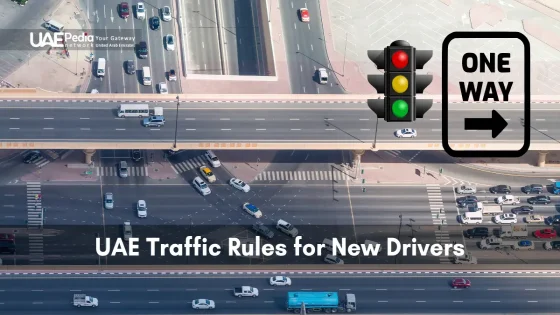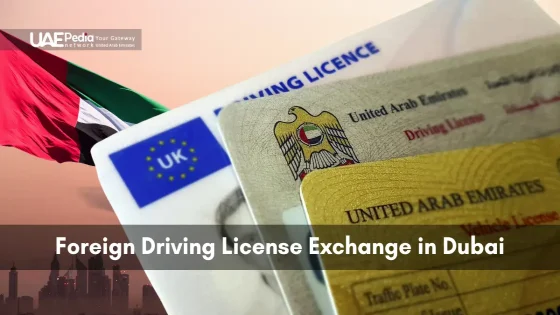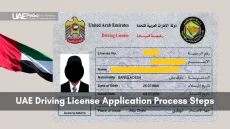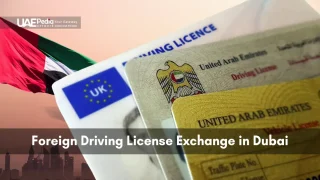Did you know drivers as young as 17 can now legally navigate Dubai’s eight-lane highways? This recent shift in road regulations reflects the Emirates’ evolving approach to safety and accessibility. Whether you’re fresh off a plane or swapping metro cards for car keys, understanding local driving culture unlocks both freedom and responsibility.
We’ve crafted this guide like a seasoned friend sketching directions on a café napkin. You’ll find clear explanations of right-of-way customs, updated age requirements, and smart strategies for handling Abu Dhabi’s iconic Sheikh Zayed Road. Our tips blend official policies with street-smart wisdom—like why checking speed limits matters more during sandstorms.
Here’s what makes this your go-to resource:
- Latest updates on licensing and enforcement straight from transport authorities
- Visual guides to decoding road signs (no Arabic fluency needed)
- Proven techniques for merging smoothly into fast-paced traffic circles
Understanding UAE Traffic Rules for New Drivers
Picture this: you’re cruising down a palm-lined avenue, radio humming an Arabic pop tune, when suddenly flashing lights appear in your rearview. Not police—just Emirati drivers politely signaling they’d like to pass. This blend of modern infrastructure and cultural courtesy defines local driving life.
Abu Dhabi’s zero-tolerance speed enforcement triggers fines at just 1 km/h over posted limits—unlike other emirates’ 20 km/h buffer zones Ref.: “UAE Government (2023). Federal Traffic Law No. 21 of 2023. Ministry of Interior Official Gazette.”
Navigating the Rulebook
Speed limits here aren’t suggestions—they’re strictly enforced with smart cameras. Residential zones cap at 40 km/h, while highways allow 120-140 km/h depending on signage. Seat belts? Non-negotiable for everyone in the car. RTA data shows these simple steps reduce collision injuries by 45%.
Right-hand driving means overtaking happens on the left. We’ve seen tourists panic when trying to merge—remember, indicators are your best friends. One local instructor told us: “Treat roundabouts like clock faces—enter at 6 o’clock, exit toward your destination number.”
Safety as Your Co-Pilot
Newcomers often underestimate desert weather’s impact. Sandstorms can drop visibility to zero in minutes. Transport authorities recommend keeping emergency kits with reflective triangles—a rule many only learn after their first roadside hiccup.
Understanding signals goes beyond red and green. Flashing amber arrows mean prepare to yield, while blue signs indicate hospital zones with strict noise rules. These details transform confusing moments into confident decisions behind the wheel.
Minimum Driving Age and Licensing Requirements in the UAE
Imagine flipping through your passport stamps and realizing one could’ve been a driver’s license at 17. A 2024 federal decree made this possible, letting eligible residents hit the road younger than ever. Let’s unpack what this means for aspiring drivers.
Youth Behind the Wheel
October 2024’s policy shift mirrors trends in countries like Norway and Japan. Teens can now apply for light vehicle licenses at 17—though parental consent remains mandatory. Driving schools report a 30% enrollment spike since the change. One instructor shared: “We’ve adapted courses with more simulation tech to build muscle memory early.”
Paperwork Made Simple
Gathering documents feels like prepping for a desert safari—better organized than sorry. Essentials include:
- Emirates ID with birthdate verification
- Recent eye test (no coffee beforehand—those pupils need steady focus)
- Passport-sized photos against white background
Pro tip: Book medical tests first—they’re valid only 30 days. Transport authorities now use blockchain for registration checks, so ensure your Emirates ID chip works. Arrive early at RTA centers; morning slots fill faster than Dubai Fountain selfie spots.
This policy positions the Emirates alongside global leaders in youth mobility. Just remember—age isn’t everything. Confidence comes from knowing your papers are as road-ready as your ride.
Crucial Enforcement and Penalties Under UAE Traffic Laws
Picture merging onto Sheikh Zayed Road at golden hour when a sports car blurs past at double the limit. That driver’s facing more than raised eyebrows—strict penalties now anchor the legal system. Recent updates under Article 31 transform how authorities handle violations, prioritizing safety through concrete consequences.
Arrestable Offenses and Serious Infractions
Certain actions trigger immediate legal action. Causing accidents with injuries? That’s not just a fine—it’s potential jail time. We’ve seen cases where refusing to share ID during stops escalated to overnight detainment. Key arrest-worthy acts include:
| Violation | Minimum Fine | Legal Consequences |
|---|---|---|
| Hit-and-run incidents | AED 20,000 | 3-month license suspension + vehicle impound |
| Refusing breathalyzer | AED 10,000 | Mandatory court appearance |
| Street racing | AED 50,000 | 30-day imprisonment (repeat offenders) |
Strict Penalties for Impaired Operation
Drinking and driving here isn’t a gray area—it’s a hard stop. Even 0.04% blood alcohol content lands you in hot water. One expat shared: “I learned the hard way—my weekend rental cost me AED 30k and a month without my passport.” First-time DUI penalties include:
- 30-day minimum jail term
- AED 25,000 fine (doubles for repeat offenses)
- 6-month driving ban
These regulations aren’t about punishment—they’re guardrails for shared safety. As authorities often remind us: “Your license isn’t a right; it’s earned through responsible choices.”
Navigating Procedures for Unrecognized Foreign Licences and Suspended Licences
Imagine arriving with your home country’s driver’s license tucked in your wallet, only to discover it’s as valid here as a grocery list. Transport authorities treat unrecognized foreign permits like expired milk—strictly off-limits. Let’s explore what happens when documentation doesn’t meet local standards.
When Paperwork Falls Short
First-time offenders using invalid international licenses face fines up to AED 10,000—roughly $2,725. One traveler shared: “I assumed my Australian license was golden. That rental car mistake cost me three days’ salary.” Repeat violations? Penalties escalate faster than desert temperatures:
| Violation Type | First Offense Fine | Repeat Offense Consequences |
|---|---|---|
| Unrecognized License Use | AED 2,000–10,000 | 1–3 months imprisonment + AED 15,000 fine |
| Expired Foreign Permit | AED 5,000 | Vehicle impound + court hearing |
| Forged Documentation | AED 20,000 | Criminal charges + deportation risk |
The Suspension Tightrope
Driving with a revoked license isn’t just risky—it’s financial Russian roulette. Authorities impound vehicles for 30 days minimum, plus AED 10,000 fines. Here’s the kicker: your car’s registration gets flagged, complicating future rentals or sales.
A legal advisor warned: “Three suspensions trigger permanent blacklisting from licensing centers.” Always check your permit status online before turning the ignition. Transport departments update databases faster than social media trends—assumptions won’t cut it.
Smart move? Book a 20-minute consultation with approved driving schools. They’ll verify your documents and outline conversion steps. Remember: proper prep today keeps legal headaches miles away tomorrow.
Guidelines for 17-Year-Olds: New Licensing Policies
The morning sun glints off Dubai’s skyline as a teen adjusts their rearview mirror—a scene made possible by recent policy shifts. Young applicants now navigate a streamlined yet thorough process to earn their driving license, blending opportunity with responsibility.
Roadmap to Registration
Getting started feels like prepping for a high-stakes video game—every level requires specific tools. Here’s how 17-year-olds can power up:
| Step | Action | Key Details |
|---|---|---|
| 1 | School Enrollment | Choose RTA-approved centers offering youth-focused programs |
| 2 | Parental Approval | Notarized consent forms + guardian’s Emirates ID copy |
| 3 | Theory Mastery | 8 interactive sessions covering road signs & hazard response |
| 4 | Practical Training | 40 hours minimum, including night driving simulations |
Driving Schools Level Up
Instructors report classrooms buzzing like gaming arcades—teens tackle VR sandstorm scenarios before touching real wheels. One trainer noted: “We’ve added age-specific modules—like managing peer pressure during joyrides.” Enrollment surged 37% since the policy launched, pushing schools to extend operating hours.
Despite the lower entry age, testing stays rigorous. Final exams include emergency braking drills and parallel parking between luxury SUVs. Pass rates? Comparable to older applicants—proof that structured lessons bridge enthusiasm with expertise.
Tips for Safe Driving and Maintaining Vehicle Compliance
Think of your car as a dance partner—smooth moves require rhythm and regular check-ins. Whether navigating desert highways or city streets, blending defensive strategies with mechanical awareness keeps you gliding safely.
Eyes Up, Mind Present
Defensive driving starts before turning the key. Scan mirrors like you’re checking your phone—quickly and often. One instructor advises: “Pretend every other driver just failed their test. Anticipate surprises.” Key habits:
- Keep 4-second gaps between vehicles—double during sandstorms
- Check blind spots before lane changes, even with smart sensors
- Use headlights at dusk; 62% of collisions happen in low light
Paperwork Meets Pavement
Your vehicle’s health matters as much as your skills. Annual registration tests now include:
| Checkpoint | Pass Standard | Common Failures |
|---|---|---|
| Tread Depth | 1.6mm minimum | Worn inner edges (underinflation) |
| Brake Fluid | Clear, above MIN | Dark/discolored liquid |
| Light Alignment | No glare to others | Misadjusted LED beams |
Comprehensive insurance isn’t optional—it’s your financial airbag. A recent case saw a driver avoid AED 80,000 in costs after a rear-end collision. Pro tip: Snap timestamped photos of maintenance work. Service records boost resale value and simplify registration renewals.
Exploring Broader Traffic Regulations and Real-World Driving Scenarios
Your phone buzzes with a sandstorm alert just as you spot brake lights ahead—welcome to real-world driving dynamics here. Beyond speed limits and licenses, mastering these moments separates confident drivers from nervous newcomers.
Handling Emergencies and Accident Protocols
When tires screech and dust swirls, follow this drill:
- Activate hazard lights immediately—they’re your first shout for help
- Place reflective triangles 50 meters behind your vehicle (100m on highways)
- Snap photos of damage and license plates before moving cars
One Abu Dhabi paramedic advises: “Dial 999 before checking injuries—seconds save lives here.” Authorities prioritize clear roads, so minor fender-benders require swift documentation.
Driving in High-Speed and Urban Environments
Merging onto a 140 km/h highway? Treat acceleration lanes like airport runways—build speed fast. In cities, watch for sudden lane shifts near construction zones. Pro tips:
- Green signs with Arabic script often mark historical districts—slow down
- Use apps like Waze for real-time news about camel crossings or detours
- Flash headlights twice to signal yielding at unmarked intersections
“Roundabouts at rush hour feel like musical chairs—know your exit before entering.”
Bilingual signs use symbols universally, but studying common Arabic phrases like “إشغال” (roadwork) builds confidence. Remember: staying cool when plans unravel makes you part of the solution, not the gridlock.
Reflections on the Future of UAE Driving Regulations
The horizon of the Emirates’ roads stretches with innovation—a living ecosystem where tradition meets adaptive laws. Lowering the driving age to 17 isn’t just policy tweaking. It’s cultural evolution, empowering youth while demanding sharper safety awareness.
Expect smarter integration of tech and regulation. Think AI-powered license tests that adapt to weather conditions, or penalties calibrated to real-time traffic data. Countries like Sweden already blend these approaches—the UAE could pioneer their desert-ready versions.
Education will likely shift from classrooms to augmented reality. Imagine practicing emergency stops in virtual sandstorms via VR headsets. Stricter vehicle inspections might sync with automated maintenance alerts, reducing human error.
Staying updated matters more than ever. Bookmark resources like our guide to recent legislative updates. Share experiences in local driver forums—your insights shape tomorrow’s regulations.
Progress here balances on two wheels: embracing change while anchoring to non-negotiable safety standards. As roads grow smarter, our collective responsibility sharpens. Drive curious, stay prepared, and watch this space—the journey’s just accelerating.
Yes! Sharjah and Dubai recently lowered the minimum driving age to 17 for residents with parental consent. Teens must complete mandatory lessons at approved schools like Emirates Driving Institute before hitting the roads solo.
Driving with a suspended license risks fines up to 5,000 dirhams and vehicle impoundment for 30 days. Repeat offenders face harsher penalties – we’ve seen cases with 3-month impounds and doubled fines under Federal Traffic Law No. 21.
If your home country’s license isn’t GCC-recognized, you’ll need an International Driving Permit plus your original license. Rental companies like Hertz and Europcar strictly enforce this – no exceptions, even for short-term visitors.
Absolutely, but with caveats. Front-facing dashcams are permitted if they don’t obstruct vision. However, recording pedestrians or other drivers without consent violates privacy laws – keep footage for insurance claims only.
Get caught texting or calling without hands-free? That’s an 800 dirham fine and 4 black points. Dubai Police’s smart cameras now detect phone use through windshield reflections – safer to Bluetooth up!
A> You’ve got a 30-day grace period post-expiry. After that, daily fines of 25 dirhams kick in (max 500). Pro tip: Schedule renewal through the RTA app 30 days early to avoid testing center queues.
A> Only if you’re a tourist with a license from approved countries like the US or UK. Residents must convert to a UAE license within their first 6 months – rental companies check visa status rigorously.















